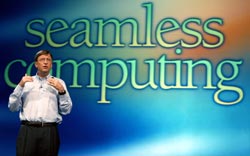LAS VEGAS, Nov. 16, 2003 — Some highlights from tonight’s COMDEX Las Vegas 2003 keynote, in which Microsoft Chairman and Chief Software Architect Bill Gates outlined the company’s vision for Seamless Computing, a framework for software innovation that addresses the fundamental issues computer users face today:

Microsoft Chairman and Chief Software Architect Bill Gates, discussing his vision for Seamless Computing at COMDEX Las Vegas 2003 Nov. 16. Click image for high-res version.
The Digital Decade: Technology Pervading Our Lives
Gates describes this as the Digital Decade, one in which many people are increasingly seeing the transition to digital information and computing power pervade most aspects of home and work life. Though much progress has been made, Gates emphasized that technology’s potential is still far from being realized.
By the end of the decade, we’ll have over a half-billion people who, [for] so many things that they do, whether it’s scheduling, photos, music, organizing meetings, planning forecasts, all those things will be done driven by software assists. And so there’s more productivity to be gained in the advances that will come in the rest of this decade than the industry has delivered in our entire history up to this date.
The Next Great Opportunity for Technology: Seamless Computing
Gates said the next great opportunity for the technology industry is to create software that breaks down the barriers between people, systems and information. Gates described this technology vision as Seamless Computing, and to realize it, Gates says the industry must deliver key software breakthroughs that create a platform and standards to allow digital information and systems to more easily work together.
In this decade, we’re engaged on delivering the final level of infrastructure, which is a software connecting infrastructure that connects all your different information together, that lets you work in a very natural way, connects you up to your speech, and your ink, and your photos, all those natural things. And so we talk about this as Seamless Computing, the idea that we, through advanced software, will be able to eliminate those things.
Seamless Computing Today: Laying the Foundation
Gates said that the vision for Seamless Computing is as much evolutionary as revolutionary, an idea that is already underway. Developing XML standards for sharing information, for instance, or computing platforms that allow applications to access and share data across multiple form factors are elements of a Seamless Computing world that are already being realized in such Microsoft products — or industry-partner products built on Microsoft technology — as the Tablet PC, SPOT devices, Smartphones, Xbox, Windows Server 2003 and the new Microsoft Office System 2003.
The hardware is not holding us back, in fact, it’s rushing ahead with some wonderful capabilities. The cost of the hardware to implement these systems will be very low. Even the natural form factors that we need for reading and tablets, and wrist type devices, pocket devices, those are coming along at very full speed. The communications cost, that evolved in the ’90s, continues to improve. So again there, if you look at an IT budget, that can be less and less of it. We have to tackle the things that build in cost, developing applications, managing the network, making sure that everything is running well
Focusing on the Fundamentals
Gates emphasized that a key piece to realizing Seamless Computing is getting the fundamentals of computing right, namely security, reliability and manageability. Computing systems must solve these software problems, Gates said, to allow IT departments to focus less on managing their systems, and more on creating innovative new applications and systems.
The framework we’re in is one where we’ve got to free up overhead in IT in order that those dollars can go against the new applications, go against Web service development, getting the wireless networks in, being ambitious about these new possibilities. And so it’s quite a challenge to all of us in the industry to meet that expectation but that’s something that’s very doable.
Seamless Computing and Windows “Longhorn”
Gates discussed the work underway in developing Windows “Longhorn” the next edition of Windows, and how it fit into the Seamless Computing vision.
There’s a lot in “Longhorn” and the theme really fits into the seamless computing idea that I’m talking about tonight. There are seams as you sit down to your PC, the way you think of mail versus file, the way you think of browsing, the way you think of photos versus music, the way you think of annotating any one of those things or searching any one of those things; it’s quite different. And yet if we had a powerful storage mechanism, which is what the Windows File System brings, we would change that.
Likewise, we want to bring visualization to a whole new level. That was one thing that people seeing the “Longhorn” prototype really were jazzed about, because it’s so visual, it’s so exciting to say, hey, this is a whole new level of taking the silicon magic and an approach to writing user interfaces that is way more.
Looking Forward: Seamless Computing Realized
Gates described Seamless Computing as an industry-wide vision, and one that will require continued cooperation at all levels to develop the platform, standards and technology upon which the next generation of connected applications and devices can be built.
There’s a lot of work here for everyone. Customers have to weigh in on what the priorities are, making sure we strike the right balance on issues like the privacy and security issues. Competitors are going to come together to make sure that the standards are driving interoperability to this level, and I think we’ve done very well on that to date, but with still much more to be done.




